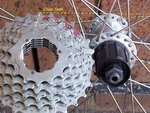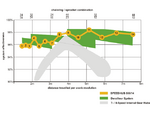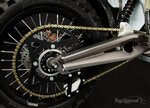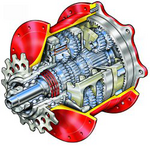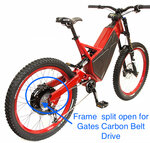Mike leroy
Active Member
Chain links pulled around the chainring can be stressed to unimaginable levels (300kg per square mm) which create microscopic gaps (0.1mm) in the chain links. Recall when accelerating very hard that the entire bike force is directly centered on the forward most chain link. To appreciate the pressure, quickly lift your bike over your head only using the tip of your pinky finger. Oh, yeah!
The gap in the chain link is half the thickness of a human hair. Dirt and mud can clog chain link rollers by entering imperceptible gaps. Clogged rollers can bring a bike to a sudden and dangerous standstill, that ejects the rider from the bike.

Layout of a roller chain: 1. Outer plate, 2. Inner plate, 3. Pin, 4. Bushing, 5. Roller
The chain link rollers serve the critical function to release a chain link from the chainring, when the link reaches the bottom of the sprocket. If the roller cannot rotate, then chain-suck will likely cause the entire crankset to seize up. The risk of being ejected from the bike is real.
Chain-suck diagram:

The amount of stress exerted on a chain depends on the number of teeth on a sprocket. The ratio of teeth between front (i.e., chainring) and rear sprockets (i.e., cassette gears) also affects the amount of pressure exerted on each chain link.

Finally, the alignment between front and rear sprockets affects the amount of pressure applied to a chain. In a single front and rear sprocket configuration like a motorcycle, all pressure is directly aligned along the chain. As more, thicker gears are added to the rear cassette, alignment between front and rear sprockets decreases. More gears also implies thinner chains.
A chainring/rear sprocket tooth ratio greater than 0.55 for a rider under 100kg is mandatory for
Rohloff chains. Rohloff manufactures the strongest and most durable bike gear systems, which often last over 60,000 miles ridden by professionals.
Bosch motor sprockets (16 tooth chainring) connected to an 11 gear rear cassette represent the high wear scenario. A motorcycle configuration of just one front and rear sprocket is an example of least chain wear.
On a Haibike XDuro, which has chain-suck issues, the tooth ratio may be as low as is 16 / 36 = 0.44, or 22% lower than the Rohloff hard limit for a straight chain. I will actually have the reverse on my bike, 26/13 because the Rohloff IGH has a 528% gear ratio. So, the front/rear tooth ratio for Rohloff is four times higher than Bosch/Haibike XDuro ratio.
Put this into perspective with a conventional mountain bike. The Santa Cruz Heckler, for example, uses Sram S1000 2x10 22/34 crankset. The Bosch has 16 teeth, or 25% fewer teeth than the 22 tooth Heckler.
The Zero motorcycle has an outrageous front/rear tooth ratio, like Bosch. I am beginning to think the problem with mud in chains that stops the Bosch motor is related to the chain construction or the cassette twisting the chain. Might also be due to the huge wear on the pins that causes the chain to stretch excessively. My hunch is the chain is stretched so much that dirt builds up to the point that the chain links cannot bend around the chainring. Like so many small wedges stiffen the chain. Alternatively, the link pitch angle is altered to the point that the links cannot bend around the sprocket.
If you have experienced chain-suck, your cassette may have too high a gear ratio for the Bosch chainring. You might consider replacing the entire drivetrain. Replacing the chain without also replacing the chainring is one of the most dangerous changes.
Chain-suck process.

Obviously, any chain angle, weaker chain brands or heavier riders will raise the risk. I do not want to publicly speculate about how low the limit falls, but it should be obvious to anyone who takes a close look at the hooked teeth on a damaged chainring . The high Risk, low Cost and low lifespan Economy of this configuration is illustrated in the following Star Plot:

To discuss related topics of a personal nature, please join the conversation.
The gap in the chain link is half the thickness of a human hair. Dirt and mud can clog chain link rollers by entering imperceptible gaps. Clogged rollers can bring a bike to a sudden and dangerous standstill, that ejects the rider from the bike.
Layout of a roller chain: 1. Outer plate, 2. Inner plate, 3. Pin, 4. Bushing, 5. Roller
Chain-suck diagram:
The amount of stress exerted on a chain depends on the number of teeth on a sprocket. The ratio of teeth between front (i.e., chainring) and rear sprockets (i.e., cassette gears) also affects the amount of pressure exerted on each chain link.
A chainring/rear sprocket tooth ratio greater than 0.55 for a rider under 100kg is mandatory for
Rohloff chains. Rohloff manufactures the strongest and most durable bike gear systems, which often last over 60,000 miles ridden by professionals.
Bosch motor sprockets (16 tooth chainring) connected to an 11 gear rear cassette represent the high wear scenario. A motorcycle configuration of just one front and rear sprocket is an example of least chain wear.
On a Haibike XDuro, which has chain-suck issues, the tooth ratio may be as low as is 16 / 36 = 0.44, or 22% lower than the Rohloff hard limit for a straight chain. I will actually have the reverse on my bike, 26/13 because the Rohloff IGH has a 528% gear ratio. So, the front/rear tooth ratio for Rohloff is four times higher than Bosch/Haibike XDuro ratio.
Put this into perspective with a conventional mountain bike. The Santa Cruz Heckler, for example, uses Sram S1000 2x10 22/34 crankset. The Bosch has 16 teeth, or 25% fewer teeth than the 22 tooth Heckler.
The Zero motorcycle has an outrageous front/rear tooth ratio, like Bosch. I am beginning to think the problem with mud in chains that stops the Bosch motor is related to the chain construction or the cassette twisting the chain. Might also be due to the huge wear on the pins that causes the chain to stretch excessively. My hunch is the chain is stretched so much that dirt builds up to the point that the chain links cannot bend around the chainring. Like so many small wedges stiffen the chain. Alternatively, the link pitch angle is altered to the point that the links cannot bend around the sprocket.
If you have experienced chain-suck, your cassette may have too high a gear ratio for the Bosch chainring. You might consider replacing the entire drivetrain. Replacing the chain without also replacing the chainring is one of the most dangerous changes.
Chain-suck process.
Obviously, any chain angle, weaker chain brands or heavier riders will raise the risk. I do not want to publicly speculate about how low the limit falls, but it should be obvious to anyone who takes a close look at the hooked teeth on a damaged chainring . The high Risk, low Cost and low lifespan Economy of this configuration is illustrated in the following Star Plot:
Attachments
Last edited:
